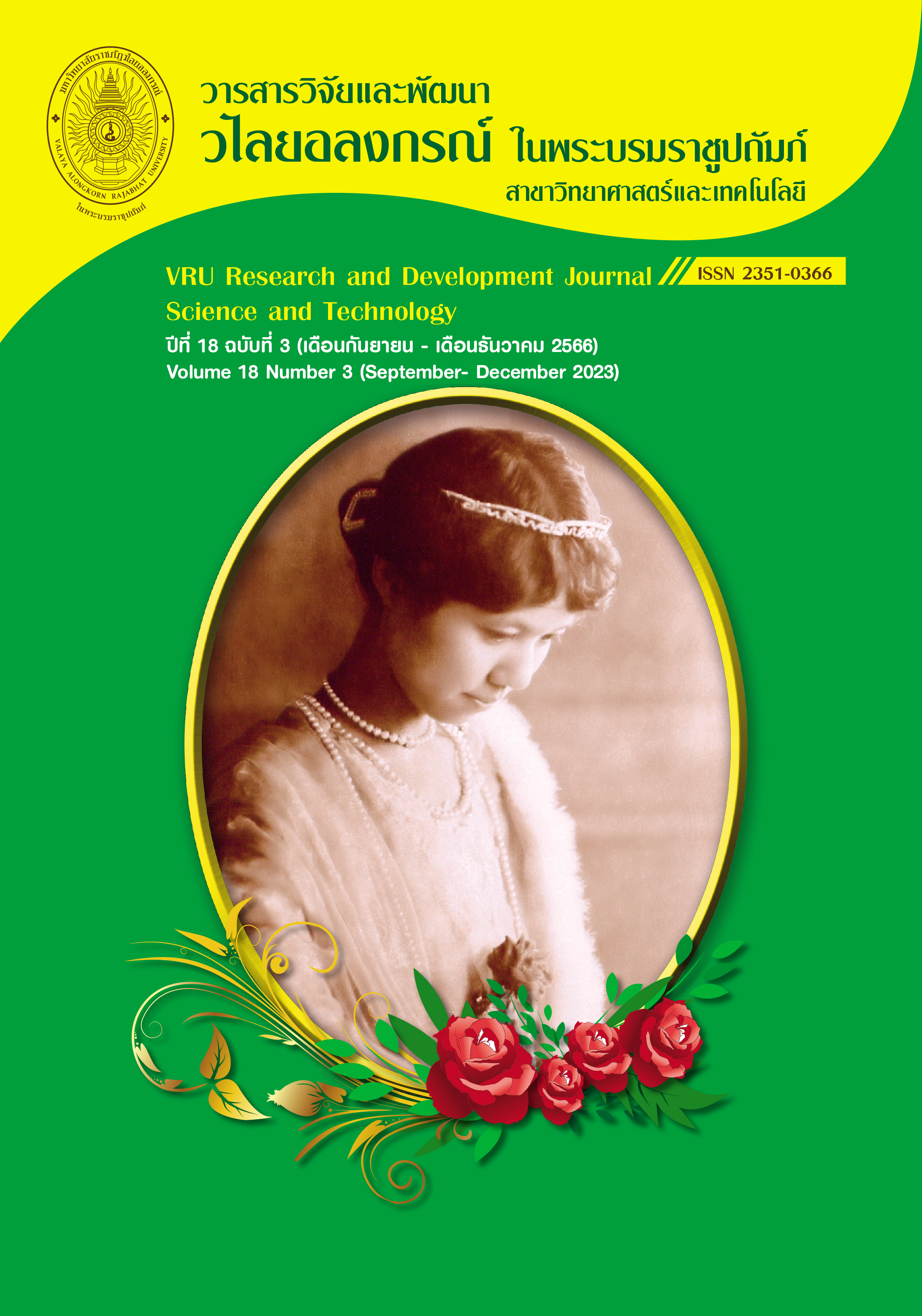THE ASSOCIATIONS BETWEEN THE HEALTH BELIEF MODEL AND UPTAKE OF BOOSTER VACCINATION AGAINST CORONAVIRUS 2019 INFECTION AMONG THE POPULATION IN CHAIYAPHUM PROVINCE
Main Article Content
Abstract
The Health Belief Model (HBM) is a psychological theory related to individuals' decision-making processes in seeking guidance and making positive and appropriate changes in their overall health behavior. It has been widely used, particularly during the current COVID-19 pandemic, where the increase in morbidity and mortality rates emphasizes the need for effective health behavior changes. Vaccination is considered the most effective way to reduce the severity and mortality rates of COVID-19. However, some groups of people are still hesitant to receive the vaccine. This cross-sectional study aimed to investigate: 1) the rate of booster vaccination against coronavirus 2019, 2) the level of the Health Belief Model in relation to booster vaccination, and 3) the relationship between the Health Belief Model and booster vaccination behavior. The study was conducted among a sample population of 1,872 individuals in Chaiyaphum province using multi-stage sampling. Data were collected through questionnaires from January to April 2023 and analyzed using descriptive and simple logistic regression statistics.
The study found that the vaccination rate was 91.24%, and the overall health belief level was at a moderate level ( = 112.99.; S.D = 14.80). In the HBM classification, perceived susceptibility (
= 20.20; S.D = 4.00) and self-efficacy (
= 11.15; S.D = 2.28) were found to be at a high level. Perceived susceptibility to infection (OR = 2.11, 95%CI = 1.08-4.12, p-value = 0.028), the perception of benefits (OR = 3.64, 95%CI = 2.04-6.48, p-value < 0.001), and self-efficacy (OR = 3.38, 95%CI = 1.91-6.00, p-value < 0.001) were statistically significant factors influencing booster vaccination behavior. This study suggests that government agencies should create and develop communication channels focusing on the factors of the Health Belief Model to provide information about COVID-19 vaccination to prevent the spread of the virus.
Downloads
Article Details
ลิขสิทธิ์บทความวิจัยที่ได้รับการตีพิมพ์เผยแพร่ในวารสารวิจัยและพัฒนา วไลยอลงกรณ์ ในพระบรมราชูปถัมภ์ ถือเป็นกรรมสิทธิ์ของสถาบันวิจัยและพัฒนา มหาวิทยาลัยราชภัฏวไลยอลงกรณ์ ในพระบรมราชูปถัมภ์ ห้ามนำข้อความทั้งหมดหรือบางส่วนไปพิมพ์ซ้ำ เว้นแต่จะได้รับอนุญาตจากมหาวิทยาลัยเป็นลายลักษณ์อักษร
ความรับผิดชอบ เนื้อหาต้นฉบับที่ปรากฏในวารสารวิจัยและพัฒนา วไลยอลงกรณ์ ในพระบรมราชูปถัมภ์ เป็นความรับผิดชอบของผู้นิพนธ์บทความหรือผู้เขียนเอง ทั้งนี้ไม่รวมความผิดพลาดอันเกิดจากเทคนิคการพิมพ์
References
กรมการแพทย์. (2565). แนวทางเวชปฏิบัติ วินิจฉัย การรักษา และการป้องกันโรคติดเชื้อในโรงพยาบาลกรณีโรคติดเชื้อไวรัสโคโรนา 2019. สืบค้นจาก https://covid19.dms.go.th/backend/Content/Content_File/Content_File/Covid_Health/Attach/25650518154445PM_CPG_COVID19_v.23_n _20220518.pdf.
กรมควบคุมโรค. (2564). แนวทางการให้วัคซีนโควิด-2019 ในสถานการณ์ระบาดปีของประเทศไทย. สืบค้นจาก https://ddc.moph.go.th/uploads/files/1729520210301021023.pdf
กรมควบคุมโรค. (2565). สถิติและรายงานจำนวนผู้ป่วยโรคติดเชื้อไวรัสโคโรนา 2019 ของประเทศไทย. สืบค้นจาก https://ddc.moph.go.th/covid19dashboard/dashboard/main.
กรมวิทยาศาสตร์การแพทย์. (2566). สถานการณ์การเฝ้าระวังสายพันธุ์โควิด 19 และสายพันธุ์ที่เฝ้าติดตามในประเทศไทย. สืบค้นจาก https://www3.dmsc.moph.go.th/post-view/1878.
ณัฐพร มาอุ่น, และวลัยพร รัตนเศรษฐ. (2565). ปัจจัยที่มีความสัมพันธ์ต่อการเข้าถึงการรับความช่วยเหลือในนโยบายฉีดวัคซีนของกลุ่มผู้สูงอายุ ในเขตเทศบาลนครนนทบุรี. วารสารบัณฑิตศึกษา มหาวิทยาลัยบัณฑิตย์, 10(3), 420-429.
สำนักงานสาธารณสุขจังหวัดชัยภูมิ (2565). ข้อมูลผู้ป่วยและวัคซีนเกี่ยวกับโรคติดเชื้อไวรัสโคโรนา 2019. สืบค้นจาก https://datastudio.google.com/u/0/reporting/e0f9f7f4-07b8-42b0- bf67-fe8ebc65a0fa/page/z9qlC.
อุดม ลิขิตวรรณวุฒิ. (2564). ข้อโต้เถียงเกี่ยวกับการฉีดวัคซีน (โควิด) กระตุ้น. สืบค้นจาก http://www.tncathai.org/images/NCAB/ncab-article119.pdf.
Bar-On, Y. M., Goldberg, Y., Mandel, M., Bodenheimer, O., Freedman, L., Kalkstein, N., ... & Huppert, A. (2021). Protection of BNT162b2 vaccine booster against Covid-19 in Israel. New England Journal of Medicine, 385(15), 1393-1400.
Becker, M. H., Maiman, L. A., Kirscht, J. P., Haefner, D. P., & Drachman, R. H. (1977). The health belief model and prediction of dietary compliance: A field experiment. Journal of Health and Social Behavior, 18(4), 348-366.
Best, J. W. (1977). Research in Education. (3rd Ed). Englewood Cliffs, New Jersey: Prentice Hall, Inc.
Chen, H., Li, X., Gao, J., Liu, X., Mao, Y., Wang, R., ... & Dai, J. (2021). Health belief model perspective on the control of COVID-19 vaccine hesitancy and the promotion of vaccination in China: web-based cross-sectional study. Journal of Medical Internet Research, 23(9), e29329.
Delpech, P. A., & Haynes-Smith, G. (2015). Breast self-examination and health beliefs in Grenadian women. Cancer Nursing, 38(5), E54-E59.
Elling, R., Whittemore, R., & Green, M. (1960). Patient participation in a pediatric program. Journal of Health and Human Behavior, 1(3), 183-191.
Heinzelmann, F. (1962). Factors in prophylaxis behavior in treating rheumatic fever: An exploratory study. Journal of Health and Human Behavior, 3(2), 73-81.
Hess, S., Lancsar, E., Mariel, P., Meyerhoff, J., Song, F., Van den Broek-Altenburg, E., ... & Zuidgeest, M. H. (2022). The path towards herd immunity: Predicting COVID-19 vaccination uptake through results from a stated choice study across six continents. Social Science & Medicine, 298, 114800.
Hsieh, F. Y., Bloch, D. A., & Larsen, M. D. (1998). A simple method of sample size calculation for linear and logistic regression. Statistics in Medicine, 17(14), 1623-1634.
Jamieson, S., (2004). Likert scales: How to (ab)use them. Medical Education, 38(12), 1217- 1218.
Juno, J. A., & Wheatley, A. K. (2021). Boosting immunity to COVID-19 vaccines. Nature-Medicine, 27(11), 1874-1875.
Kitro, A., Sirikul, W., Piankusol, C., Rirermsoonthorn, P., Seesen, M., Wangsan, K., ... & Sapbamrer, R. (2021). Acceptance, attitude, and factors affecting the intention to accept COVID-19 vaccine among Thai people and expatriates living in Thailand. Vaccine, 39(52), 7554-7561.
Likert, R.A. (1932). Technique for the measurement of attitudes. Archives of Psychology, 140, 1-55.
Malik, A. A., McFadden, S. M., Elharake, J., & Omer, S. B. (2020). Determinants of COVID-19 vaccine acceptance in the US. EClinicalMedicine, 26, 100495.
Mahmud, I., Kabir, R., Rahman, M. A., Alradie-Mohamed, A., Vinnakota, D., & Al-Mohaimeed, A. (2021). The health belief model predicts intention to receive the COVID-19 vaccine in Saudi Arabia: results from a cross-sectional survey. Vaccines, 9(8), 864.
Rosenstock, I. M., Strecher, V. J., & Becker, M. H. (1988). Social learning theory and the health belief model. Health Education Quarterly, 15(2), 175-183.
Seangpraw, K., Pothisa, T., Boonyathee, S., Ong-Artborirak, P., Tonchoy, P., Kantow, S., ... & Choowanthanapakorn, M. (2022). Using the Health Belief Model to Predict Vaccination Intention Among COVID-19 Unvaccinated People in Thai Communities. Frontiers in Medicine, 9, 1-9.
Shmueli, L. (2021). Predicting intention to receive COVID-19 vaccine among the general population using the health belief model and the theory of planned behavior model. BMC Public Health, 21(1), 1-13.
Wang, Y., Duan, L., Li, M., Wang, J., Yang, J., Song, C., ... & Xu, J. (2022). COVID-19 Vaccine Hesitancy and Associated Factors among Diabetes Patients: A Cross-Sectional Survey in Changzhi, Shanxi, China. Vaccines, 10(1), 129.
World Health Organization. (2022a). Situation Dashboard. Retrieved from https://covid19.who.int/measures.
World Health Organization. (2022b). WHO Coronavirus Vaccine Dashboard. Retrieved from https://covid19.who.int/?mapFilter=vaccinations.
World Health Organization. (2023). WHO Coronavirus Dashboard. Retrieved from https://covid19.who.int/mapFilter/cases.

